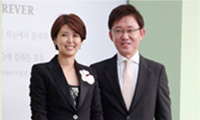A Model of Innovation That Elevates the Auteur
Designers who
anticipate needs that
don’t yet exist.
The more, the better. That’s the fashionable recipe for nurturing new ideas these days. It emphasizes a kind of Internet-era egalitarianism that celebrates the “wisdom of the crowd” and “open innovation.” Assemble all the contributions in the digital suggestion box, we’re told in books and academic research, and the result will be collective intelligence. Yet Apple, a creativity factory meticulously built by Steven P. Jobs since he returned to the company in 1997, suggests another innovation formula - one more elitist and individual. This approach is reflected in the company’s latest potentially gamechanging gadget, the iPad tablet, unveiled recently. It may succeed or stumble but it clearly carries the taste and perspective of Mr. Jobs and seems stamped by the company’s earlier marketing motto: Think Different.
Apple represents the “model of innovation,” observes John Kao, a consultant to corporations and governments on innovation. In the auteur model, he said, there is a tight connection between the personality of the project leader and what is created. Movies created by powerful directors, he says, are clear examples, from Alfred Hitchcock’s “Vertigo” to James Cameron’s “Avatar.”
At Apple, there is a similar link between the ultimate design-team leader, Mr. Jobs, and the products. From computers to smartphones, Apple products are known for being stylish, powerful and pleasing to use. They are edited products that cut through complexity, by consciously leaving things out - not cramming every feature that came into an engineer’s head, an affliction known as “featuritis” that burdens so many technology products. “A defining quality of Apple has been design restraint,” says Paul Saffo, a technology forecaster and consultant in Silicon Valley.
That restraint is evident in Mr. Jobs’s personal taste. His black turtleneck, beltless blue jeans and running shoes are a signature look. In his Palo Alto, California, home years ago, he said that he preferred uncluttered, spare interiors and then explained the elegant craftsmanship of the simple wooden chairs in his living room, made by George Nakashima, the 20th-century furniture designer .
Great products, according to Mr. Jobs, are triumphs of “taste.” And taste, he explains, is a byproduct of study, observation and being steeped in the culture of the past and present, of “trying to expose yourself to the best things humans have done and then bring those things into what you are doing.”
His is not a product-design philosophy steered by committee or determined by market research. The Jobs formula, say colleagues, relies heavily on tenacity, patience, belief and instinct. He gets deeply involved in hardware and software design choices, which await his personal nod or veto. Mr. Jobs, of course, is one member of a large team at Apple, even if he is the leader. Indeed, he has often described his role as a team leader. In choosing key members of his team, he looks for the multiplier factor of excellence.
Truly outstanding designers, engineers and managers, he says, are not just 10 percent, 20 percent or 30 percent better than merely very good ones, but 10 times better. Their contributions, he adds, are the raw material of “aha” products, which make users rethink their notions of, say, a music player or cellphone.
“Real innovation in technology involves a leap ahead, anticipating needs that no one really knew they had and then delivering capabilities that redefine product categories,” said David B. Yoffie, a professor at the Harvard Business School. “That’s what Steve Jobs has done.”
Timing is essential to make such big steps ahead. Carver Mead, a leading computer scientist at the California Institute of Technology, once said, “Listen to the technology; find out what it’s telling you.”
Mr. Jobs is undeniably a gifted marketer and showman, but he is also a skilled listener to the technology. He calls this “tracking vectors in technology over time,” to judge when an intriguing innovation is ready for the marketplace. Technical progress, affordable pricing and consumer demand all must jell to produce a blockbuster product.
Indeed, Apple designers and engineers have been working on the iPad for years, presenting Mr. Jobs with prototypes periodically. None passed muster, until recently.
The iPad bet could prove a loser for Apple. Do recall, though, that when the iPod was introduced in 2001, critics joked that the name was an acronym for “idiots price our devices.” And we know who had the last laugh that time.
스마터리빙
more [ 건강]
[ 건강]이제 혈관 건강도 챙기자!
[현대해운]우리 눈에 보이지 않기 때문에 혈관 건강을 챙기는 것은 결코 쉽지 않은데요. 여러분은 혈관 건강을 유지하기 위해 어떤 노력을 하시나요?
 [ 건강]
[ 건강]내 몸이 건강해지는 과일궁합
 [ 라이프]
[ 라이프]벌레야 물럿거라! 천연 해충제 만들기
 [ 건강]
[ 건강]혈압 낮추는데 좋은 식품
[현대해운]혈관 건강은 주로 노화가 진행되면서 지켜야 할 문제라고 인식되어 왔습니다. 최근 생활 패턴과 식생활의 변화로 혈관의 노화 진행이 빨라지고
사람·사람들
more
[‘파친코’ 이민진 작가,인터뷰] “이민자와 취약계층 보호해야”
재미 한인 작가 이민진(57)씨가 새해 1월1일 뉴욕시장으로 취임하는 조란 맘다니(34) 뉴욕시장 당선인에 대해 “맘다니 시장이 긍정적인 변화…

김응화무용단, LA 카운티 연말축제서 ‘화관무’
김응화무용단이 지난 24일 열린 LA 카운티 연말 문화행사 제66회‘할러데이 축제’ 무대에 초청돼 한국 전통무용 ‘화관무’를 선보였다고 밝혔다…
이민단속·산불 영향 LA카운티 인구 감소
LA 카운티 인구가 올해 상당수 감소한 것으로 나타났다. 캘리포니아 주 재무국이 최근 발표한 자료에 따르면 올해 7월1일 기준 LA카운티의 인…
한인 2세, 드라마 ‘런’ 주연 맡아
권호열 세계무술총연맹 총재의 아들 에릭 권씨가 주연하는 드라마 ‘런(RUN)’ 시사회가 지난주 버지니아 애쉬번 소재 리걸 폭스 극장에서 열렸다…
[송년 행사] 코윈 퍼시픽 LA
한민족 여성네트워크(KOWIN) 퍼시픽 LA(회장 조미순)는 23일 LA 용수산에서 2025년 송년회를 열었다. 이날 행사에는 가정폭력 피해 …
많이 본 기사
- “유부남과 엘리베이터서 진한 키스” 트로트 女가수 상간 ‘충격’
- ‘韓월드컵 경기’ 멕시코 사포판 도심서 100여발 총격… “2명 사망”
- ‘뉴저지 헬기 충돌’ 조종사 둘 모두 사망… “친구 사이”
- 트럼프·젤렌스키 회담 하루 만에… ‘푸틴 관저 공격설’ 찬물
- 트럼프 “파월 해임하고 싶다…차기 의장 후보 내달 발표”
- 이혜훈 “내란, 민주주의 파괴 불법행위…실체파악 못했다” 사과
- ICE 단속 전략 전환… ‘현장 체포’ 급증
- “미·중 AI경쟁 현재 점수 24대 18”…H200 수출, 전환점 되나
- 주택용 전기요금 내년에도 인상 전망… “중간선거에 변수”
- 트럼프, 하마스 무장해제·이란 핵포기 압박…이스라엘에 힘싣기
- 트럼프, 네타냐후와 회담… “가자 휴전 2단계 신속 추진”
- 소프트뱅크, AI인프라 투자사 디지털브리지 40억 달러에 인수
- 영주권자도 생체정보 전면 확인 1
- 트럼프, 연말 글로벌종전외교 마무리…돌파구없었지만 동력유지
- 네타냐후, 트럼프에 노벨평화상 추천 이어 최고훈장까지
- [새해 달라지는 교통법규] 과속·음주운전 처벌 가주서 대폭 강화
- ‘87세’ 김영옥, 하반신 마비된 손자 간병.. “누구든 아픔 있어” 고백
- 국방부, 여인형·이진우·고현석 ‘파면’…곽종근은 ‘해임’
- “트럼프-머스크 화해 중재자는 차기 대권 유력주자 밴스”
- “한인 발달장애 가정 지원 프로그램”
- 故 최진실 딸 최준희, ‘개콘’서 성형 중독 고백.. “외모 만족 안 돼 “
- 진양혜母 치매, 손범수父 입원.. “병원서 자는날 늘어남” 먹먹
- 트럼프, 휴일 취재진에 식사 권하며 “뇌물로 여길건가”
- 401(k) 백만장자 50만명 돌파… 시간·복리 투자 ‘결실’
- 엔비디아, 인텔 주식 50억 달러어치 인수… ‘9월 합의’ 이행
- 신년 연휴에 또 비 이번주 ‘강풍주의보’
- 한예슬, ♥남편과 스키장서 보낸 연말..신혼 같은 로맨틱 부부
- 고금리·고가격·관세 ‘브레이크’… 신차 시장 썰렁
- 공화·민주, 내년 중간선거 앞두고 일제히 ‘이대남’ 구애
- “뉴욕주 ‘그린라이트 법’위헌 아니다“
- 메타, ‘제2의 딥시크’ 마누스 인수…AI 에이전트 진용 구비
- 미주화토산악회 송년의 밤 성황
- 2025년의 최대 패배자(Loser … 2
- 워싱턴 일원‘슈퍼 독감’비상
- 이민자 트럭 운전사들 “면허박탈 위법… 2
- 5 Fwy 다중추돌 참사 1명 사망·15명 부상
- 사유리, 아들과 기모노 가족사진.. “아빠 없어 불쌍? 웃어넘겨”
- 트럼프, 베네수엘라 마약시설 타격 시사…첫 육상 공격 가능성
- Meals Tax 미리 걷은 한인식당, 환불 약속
- 트럼프 정부, 이민 2세대까지 공격
- 지메일 주소변경 가능 구글, 앞부분 새 설정
- 건강한 노년을 위한 식사법, 무엇을 어떻게 먹어야 할까
- 러 “합의 근접했다는 트럼프에 동의…우크라, 돈바스 철군해야”
- 미국이 K-푸드 주력시장… 중국 제치고 1위 부상
- ‘진통제 투혼’ 김민재 잊었나, ‘배은망덕’ 불타는 독일 현지 여론 “가장 실망한 선수 5위”
- 다크 초콜릿·커피 속 ‘테오브로민’… “세포 노화 늦춘다”
- 시니어들 상황별 리버스모기지의 선택
- 워싱턴 일자리 4만개 없어졌다
- LA시 아파트(1978년 이전 건설) 렌트비 연 4% 이상 못 올린다
- ‘은퇴 번복→폭탄선언’ 호날두 “1000골까지 계속 뛸 것”
1/5지식톡

-
 미 육군 사관학교 West Poin…
0
미 육군 사관학교 West Poin…
0https://youtu.be/SxD8cEhNV6Q연락처:wpkapca@gmail.comJohn Choi: 714-716-6414West Point 합격증을 받으셨나요?미 육군사관학교 West Point 학부모 모…
-
 ☝️해외에서도 가능한 한국어 선생님…
0
☝️해외에서도 가능한 한국어 선생님…
0이 영상 하나면 충분합니다!♥️상담신청문의♥️☝️ 문의 폭주로 '선착순 상담'만 진행합니다.☎️ : 02-6213-9094✨카카오톡ID : @GOODEDU77 (@골뱅이 꼭 붙여주셔야합니다…
-
 테슬라 자동차 시트커버 장착
0
테슬라 자동차 시트커버 장착
0테슬라 시트커버, 사놓고 아직 못 씌우셨죠?장착이 생각보다 쉽지 않습니다.20년 경력 전문가에게 맡기세요 — 깔끔하고 딱 맞게 장착해드립니다!장착비용:앞좌석: $40뒷좌석: $60앞·뒷좌석 …
-
 식당용 부탄가스
0
식당용 부탄가스
0식당용 부탄가스 홀세일 합니다 로스앤젤레스 다운타운 픽업 가능 안녕 하세요?강아지 & 고양이 모든 애완동물 / 반려동물 식품 & 모든 애완동물/반려동물 관련 제품들 전문적으로 홀세일/취급하는 회사 입니다 100% …
-
 ACSL 국제 컴퓨터 과학 대회, …
0
ACSL 국제 컴퓨터 과학 대회, …
0웹사이트 : www.eduspot.co.kr 카카오톡 상담하기 : https://pf.kakao.com/_BEQWxb블로그 : https://blog.naver.com/eduspotmain안녕하세요, 에듀스팟입니다…
케이타운 1번가
오피니언
 옥세철 논설위원
옥세철 논설위원2025년의 최대 패배자(Loser of The Year 2025)는?

세밑의 단상(斷想)
 메건 매카들 워싱턴포스트 칼럼니스트
메건 매카들 워싱턴포스트 칼럼니스트 [메건 매카들 칼럼] 역차별 당하는 젊은 백인 남성들
 조형숙 시인·수필가 미주문협 총무이사
조형숙 시인·수필가 미주문협 총무이사 겨울 모서리
 한영일 / 서울경제 논설위원
한영일 / 서울경제 논설위원 [만화경] 봉황의 청와대 귀환

새해 더 중요해지는 노동법 준수

연말연시, 안전하고 차분하게
 캐슬린 파커 워싱턴포스트 칼럼니스트
캐슬린 파커 워싱턴포스트 칼럼니스트 [캐슬린 파커 칼럼] 지미 라이의 마지막 희망
 유경재 나성북부교회 담임목사
유경재 나성북부교회 담임목사 [한국춘추] 미국의 힘
1/3지사별 뉴스

“뉴욕주 ‘그린라이트 법’위헌 아니다“
연방법원이 뉴욕주의 이민 신분에 관계없이 운전면허 취득을 허용하는 ‘그린라이트 법’ 시행을 막으려는 도널드 트럼프 행정부의 법적 시도를 기각시…
맨하탄 교통혼잡세 판결 내년으로 넘어가

워싱턴 일자리 4만개 없어졌다
올해 초 트럼프 대통령 취임과 함께 시작된 정부효율부(DOGE)의 대대적인 연방공무원 감원 칼바람에 올 한해동안 버지니아와 메릴랜드, DC 등…
워싱턴 일원‘슈퍼 독감’비상

트럼프, 베네수엘라 마약시설 타격 시사…첫 육상 공격 가능성
도널드 트럼프 대통령이 베네수엘라의 지상 목표물을 대상으로 한 공격이 단행됐을 가능성을 처음으로 시사했다.28일 뉴욕타임스(NYT)에 따르면 …
[새해부터 이렇게 달라진다] 최저임금 또 오르고… 유급 병가는 더 확대

오늘 하루 이 창 열지 않음 닫기 




















































.png)


댓글 안에 당신의 성숙함도 담아 주세요.
'오늘의 한마디'는 기사에 대하여 자신의 생각을 말하고 남의 생각을 들으며 서로 다양한 의견을 나누는 공간입니다. 그러나 간혹 불건전한 내용을 올리시는 분들이 계셔서 건전한 인터넷문화 정착을 위해 아래와 같은 운영원칙을 적용합니다.
자체 모니터링을 통해 아래에 해당하는 내용이 포함된 댓글이 발견되면 예고없이 삭제 조치를 하겠습니다.
불건전한 댓글을 올리거나, 이름에 비속어 및 상대방의 불쾌감을 주는 단어를 사용, 유명인 또는 특정 일반인을 사칭하는 경우 이용에 대한 차단 제재를 받을 수 있습니다. 차단될 경우, 일주일간 댓글을 달수 없게 됩니다.
명예훼손, 개인정보 유출, 욕설 등 법률에 위반되는 댓글은 관계 법령에 의거 민형사상 처벌을 받을 수 있으니 이용에 주의를 부탁드립니다.
Close
x